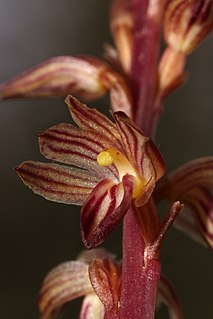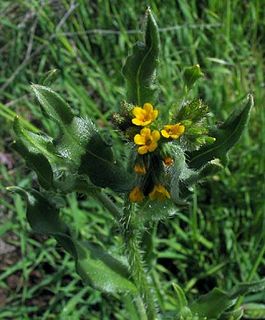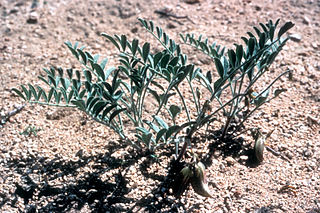
The University of California, Berkeley is a public research university in Berkeley, California. It was founded in 1868 and serves as the flagship institution of the ten research universities affiliated with the University of California system. Berkeley has since grown to instruct over 40,000 students in approximately 350 undergraduate and graduate degree programs covering numerous disciplines.

Prunus cerasifera is a species of plum known by the common names cherry plum and myrobalan plum. It is native to Southeast Europe and Western Asia, and is naturalised in the British Isles and scattered locations in North America.

Allium unifolium, the one-leaf onion or American garlic, is a North American species of wild onion. It is native to the coastal mountain ranges of California, Oregon, and Baja California. It grows on clay soils including serpentine, at elevations up to 1100 m.
Eurybia integrifolia, commonly called the thickstem aster, is an herbaceous perennial in the composite family. It is native to the western United States where it grows primarily in the Rocky Mountains, the Great Basin, and the Sierra Nevada in Washington, Idaho, Montana, Wyoming, Utah, Oregon, Nevada, and California.

Rubus ursinus is a North American species of blackberry or dewberry, known by the common names California blackberry, California dewberry, Douglas berry, Pacific blackberry, Pacific dewberry and trailing blackberry.

Cirsium occidentale, with the common name cobweb thistleor cobwebby thistle, is a North American species of thistle in the sunflower family.

Corallorhiza striata is a species of orchid known by the common names striped coralroot and hooded coralroot. This flowering plant is widespread across much of southern Canada, the northern and western United States, and Mexico. It lives in dry, decaying plant matter on the ground in pine and mixed coniferous forests, and it obtains its nutrients from fungi via mycoheterotrophy.

Erigeron foliosus, known by the common names leafy daisy and leafy fleabane, is a North American species of flowering plants in the daisy family.

Calycoseris wrightii, commonly known as white tackstem, is an annual spring wildflower, one of two species in the genus Calycoseris; the other species is C. parryi, the Yellow tack-stem. They are part of the sunflower family.

Grindelia hirsutula is a North American species of flowering plant in the daisy family known by the common names hairy gumplant and hairy gumweed.

Amsinckia menziesii is a species of plant in the Boraginaceae family, the borage or forget-me-not family.

Eschscholzia rhombipetala, the diamond-petaled California poppy, is endemic to California.

Malus fusca, with the common names Oregon crabapple and Pacific crabapple, is a North American species of crabapple.

Blitum californicum is a species of flowering plant in the amaranth family known by the common names California goosefoot and (ambiguously) "Indian lettuce".

Agoseris glauca is a North American species of flowering plants in the daisy family known by the common names pale agoseris, prairie agoseris, and short-beaked agoseris.

Astragalus ertterae is a rare species of milkvetch known by the common name Walker Pass milkvetch. It is endemic to California, where it is known from only three occurrences near Walker Pass in the Sierra Nevada.

Balsamorhiza sagittata is a North American species of flowering plant in the sunflower tribe of the aster family known by the common name arrowleaf balsamroot. It is widespread across western Canada and much of the western United States. A specimen was collected by explorer and botanist Meriwether Lewis near Lewis and Clark Pass in 1806.

Tolpis barbata is a species of flowering plant in the aster family known by the common name European umbrella milkwort. It is native to southern Europe, including the Mediterranean, and it is known in many other places as an introduced species and a common weed, such as in California and New South Wales.

The Free Speech Movement (FSM) was a massive, long-lasting student protest which took place during the 1964–65 academic year on the campus of the University of California, Berkeley. The Movement was informally under the central leadership of Berkeley graduate student Mario Savio. Other student leaders include Jack Weinberg, Michael Rossman, George Barton, Brian Turner, Bettina Aptheker, Steve Weissman, Michael Teal, Art Goldberg, Jackie Goldberg, and others.

iNaturalist is a citizen science project and online social network of naturalists, citizen scientists, and biologists built on the concept of mapping and sharing observations of biodiversity across the globe. iNaturalist may be accessed via its website or from its mobile applications. Observations recorded with iNaturalist provide valuable open data to scientific research projects, conservation agencies, other organizations, and the public. The project has been called "a standard-bearer for natural history mobile applications."





















